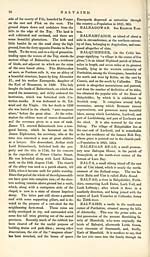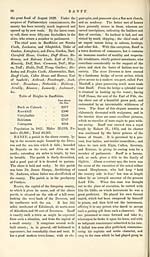Gazetteer of Scotland > Volume 1
(105) Page 77
Download files
Complete book:
Individual page:
Thumbnail gallery: Grid view | List view

BANFFSHIRE.
77
distinguished cadet, the late Lord Chief Justice
of the King's Bench.
BALVENIE, one of the districts of the
county of Banff.
BANCHORY-DAVINICK, a parish ly-
ing on both sides of the river Dee, partly in
Aberdeenshire, and partly in Kincardineshire,
bounded at the one extremity by the sea, and
extending about six miles along the river. The
district is rugged, heathy, and stony. There
is nothing worthy of particular remark in
the parish. The kirk of Banchory is on the
north bank of the Dee. — Population in 1821,
2232.
BANCHORY-TERNAN, a parish in
the counties of Kincardine and Aberdeen, far-
ther up the Dee than Banchory-Davinick,
bounded by Strachan on the south, Durris on
the east, and Mid- Mar on the north. The
village lies on the north side of the Dee In
general, this and the preceding place are writ-
ten and called Banchory ; a word which signi-
fies in the Gaelic, " an opening between two
hills."— Population in 1821, 1729.
BANFFSHIRE, a county of no great ex-
tent, lying in a longitudinal slope betwixt a
range of the Grampian hills and the Moray
firth, and respectively bounded on the east and
west by Aberdeenshire and the county of Mo-
ray. The inland extremity of Banffshire is
sharpened to a point at the head of Glen-
Avon. This district was at one time a com-
ponent part of the large province of Moray,
which altogether forms one of the finest tracts
of ground in the northern part of Scotland.
On the eastern side of the Deveron, in the
district of Buchan, the parish of Gamrie and
some other spots of ground belong to Banffshire.
That part of the country bounded by the sea
is computed at twenty-four miles in length,
and from the shore to the head of Glen- Avon
the distance is fifty miles. In all it presents
a superficies of 1015 square miles. It con-
tains two royal burghs — Cullen and Banff, and
three or four thriving villages of considerable
size. It comprehends twenty-four parishes ;
and the country, in popidar phraseology, is
divided into districts agreeable to local config-
uration. Bristling at its interior extremity is
the forest of Glen- Avon, from whence pro-
ceeds, in a north-easterly direction, the Strath
of Glen-Avon on the left, and Strath Dever-
on on the right. Betwixt these, like a bond
of connexion, is Glen-Livet, from whence, in
a north-easterly direction, again diverges Glen-
Fiddich. Nearly in continuation of this val-
ley runs the Strath of Balvenie. In the lower
part of the shire are Strath Islay, Strath Boyne,
and, crossing the Deveron, a part of Buchan.
By such an intermixture of valleys and flat
ground among the ranges of hills, the country
is agreeably diversified, and possesses many
beautiful fertile braes productive of the finest
crops, or serviceable for the excellence of their
green pasture. Its waters are the Spey, the
Livet, the Avon, the Fiddich, the Deveron,
the Isla, the Conglas, and several more minute
streams. The Deveron is not navigable, but
this, as well as the Spey (which is properly an
Inverness-shire river, though running along
part of the border of Banffshire,) yields excel-
lent salmon-fishing, and is thus the source
of great comfort and wealth to the inhabi-
tants. Along the coast there are a number
of small waters, which fall with a quick des-
cent, and are useful in turning machinery
in different little towns, where manufac-
tures have been begun. Limestone is plen-
tiful in Banffshire, and from the district of
Balvenie -hones or whetstones are dug in great
quantities. The county contains many lofty
mountains, among which Belrinnes on the
Spey, and Knockhill, a hill disjointed from
the Grampians at their northern termination,
are the principal. The climate of Banffshire
is precarious. In the hilly districts all the
evils of cold and rain are often felt, and as
frost and snows frequently set in without any
interval of good weather, the harvests are not
only endangered, but the operations of hus-
bandry are suspended for many of the winter
months. The lower part of the shire from
Duff House to Forglen, and Kinnairdy, a tract
of about twelve miles along the river side, and
from Banff to Gordon Castle, including the
districts of Boyne and Enzie, must be except-
ed, being nearly equal to the climate of Mor-
ay, and greatly surpassing the most part of the
country in the fertility of the soil, the improve-
ments of its agriculture, and the richness of its
productions. The proprietary of Banffshire
is very Umited. Nearly the whole of the
lands belong to the Duke of Gordon, the Earl
of Seafield, the Earl of Fife, and Lord
Banff, all of whom have elegant seats, though
unfortunately, here as elsewhere, the district
is abandoned to the miseries of absenteeism.
A part of Banffshire suffered serious injury by
77
distinguished cadet, the late Lord Chief Justice
of the King's Bench.
BALVENIE, one of the districts of the
county of Banff.
BANCHORY-DAVINICK, a parish ly-
ing on both sides of the river Dee, partly in
Aberdeenshire, and partly in Kincardineshire,
bounded at the one extremity by the sea, and
extending about six miles along the river. The
district is rugged, heathy, and stony. There
is nothing worthy of particular remark in
the parish. The kirk of Banchory is on the
north bank of the Dee. — Population in 1821,
2232.
BANCHORY-TERNAN, a parish in
the counties of Kincardine and Aberdeen, far-
ther up the Dee than Banchory-Davinick,
bounded by Strachan on the south, Durris on
the east, and Mid- Mar on the north. The
village lies on the north side of the Dee In
general, this and the preceding place are writ-
ten and called Banchory ; a word which signi-
fies in the Gaelic, " an opening between two
hills."— Population in 1821, 1729.
BANFFSHIRE, a county of no great ex-
tent, lying in a longitudinal slope betwixt a
range of the Grampian hills and the Moray
firth, and respectively bounded on the east and
west by Aberdeenshire and the county of Mo-
ray. The inland extremity of Banffshire is
sharpened to a point at the head of Glen-
Avon. This district was at one time a com-
ponent part of the large province of Moray,
which altogether forms one of the finest tracts
of ground in the northern part of Scotland.
On the eastern side of the Deveron, in the
district of Buchan, the parish of Gamrie and
some other spots of ground belong to Banffshire.
That part of the country bounded by the sea
is computed at twenty-four miles in length,
and from the shore to the head of Glen- Avon
the distance is fifty miles. In all it presents
a superficies of 1015 square miles. It con-
tains two royal burghs — Cullen and Banff, and
three or four thriving villages of considerable
size. It comprehends twenty-four parishes ;
and the country, in popidar phraseology, is
divided into districts agreeable to local config-
uration. Bristling at its interior extremity is
the forest of Glen- Avon, from whence pro-
ceeds, in a north-easterly direction, the Strath
of Glen-Avon on the left, and Strath Dever-
on on the right. Betwixt these, like a bond
of connexion, is Glen-Livet, from whence, in
a north-easterly direction, again diverges Glen-
Fiddich. Nearly in continuation of this val-
ley runs the Strath of Balvenie. In the lower
part of the shire are Strath Islay, Strath Boyne,
and, crossing the Deveron, a part of Buchan.
By such an intermixture of valleys and flat
ground among the ranges of hills, the country
is agreeably diversified, and possesses many
beautiful fertile braes productive of the finest
crops, or serviceable for the excellence of their
green pasture. Its waters are the Spey, the
Livet, the Avon, the Fiddich, the Deveron,
the Isla, the Conglas, and several more minute
streams. The Deveron is not navigable, but
this, as well as the Spey (which is properly an
Inverness-shire river, though running along
part of the border of Banffshire,) yields excel-
lent salmon-fishing, and is thus the source
of great comfort and wealth to the inhabi-
tants. Along the coast there are a number
of small waters, which fall with a quick des-
cent, and are useful in turning machinery
in different little towns, where manufac-
tures have been begun. Limestone is plen-
tiful in Banffshire, and from the district of
Balvenie -hones or whetstones are dug in great
quantities. The county contains many lofty
mountains, among which Belrinnes on the
Spey, and Knockhill, a hill disjointed from
the Grampians at their northern termination,
are the principal. The climate of Banffshire
is precarious. In the hilly districts all the
evils of cold and rain are often felt, and as
frost and snows frequently set in without any
interval of good weather, the harvests are not
only endangered, but the operations of hus-
bandry are suspended for many of the winter
months. The lower part of the shire from
Duff House to Forglen, and Kinnairdy, a tract
of about twelve miles along the river side, and
from Banff to Gordon Castle, including the
districts of Boyne and Enzie, must be except-
ed, being nearly equal to the climate of Mor-
ay, and greatly surpassing the most part of the
country in the fertility of the soil, the improve-
ments of its agriculture, and the richness of its
productions. The proprietary of Banffshire
is very Umited. Nearly the whole of the
lands belong to the Duke of Gordon, the Earl
of Seafield, the Earl of Fife, and Lord
Banff, all of whom have elegant seats, though
unfortunately, here as elsewhere, the district
is abandoned to the miseries of absenteeism.
A part of Banffshire suffered serious injury by
Set display mode to: Large image | Transcription
Images and transcriptions on this page, including medium image downloads, may be used under the Creative Commons Attribution 4.0 International Licence unless otherwise stated. ![]()
| Gazetteers of Scotland, 1803-1901 > Gazetteer of Scotland > Volume 1 > (105) Page 77 |
|---|
| Permanent URL | https://digital.nls.uk/97425622 |
|---|
| Description | Volume I: Abbey to Glenartney. |
|---|---|
| Attribution and copyright: |
|
| Description | By Robert Chambers and William Chambers. Glasgow: Blackie & Son, 1838. 2 volumes. |
|---|---|
| Shelfmark | NF.1461.g.7 |
| Additional NLS resources: | |

